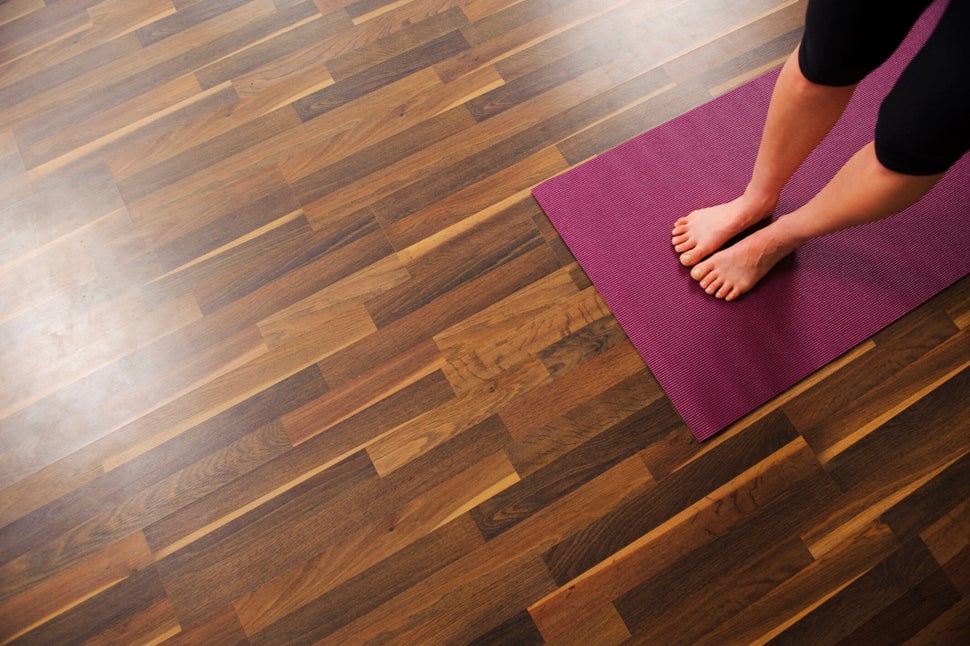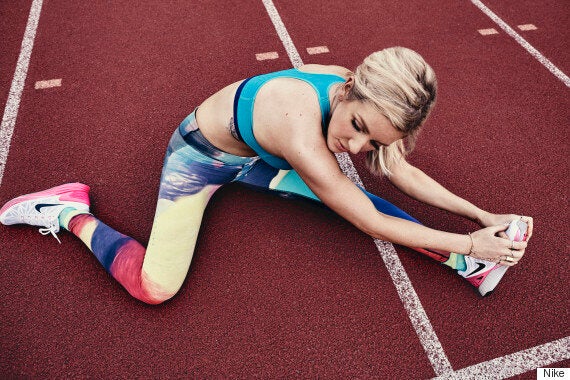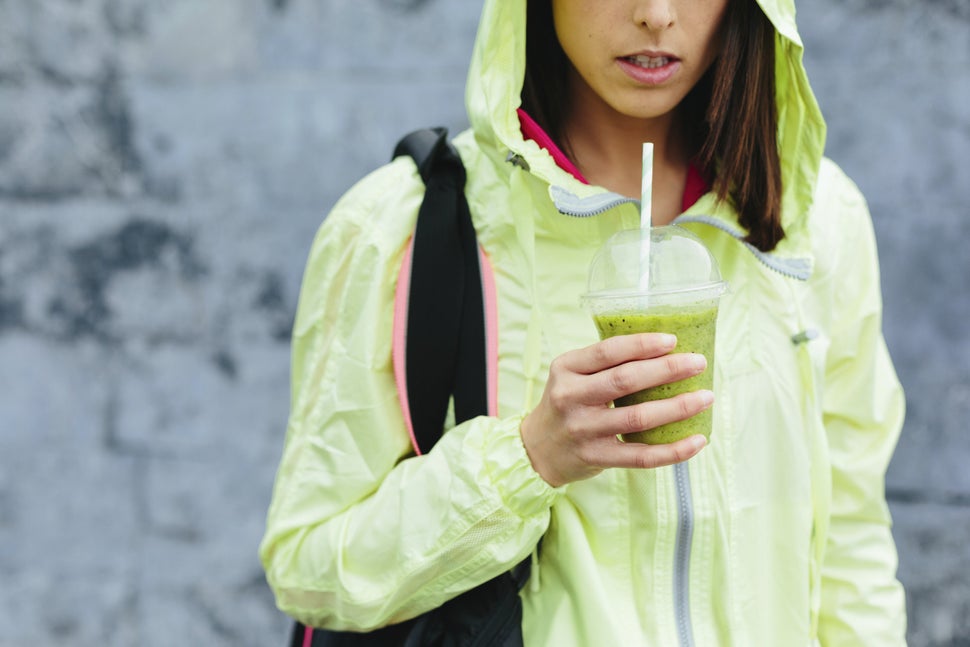
It's 5:30pm on Friday evening, and like clockwork my colleagues are trying to beckon me to the pub. But, after a hard week's work, the hot yoga class at the gym next door strikes me as a much more inviting way to unwind - and it wouldn't be the first time.
After all, I've got just six weeks until my first 10km race and my running app tells me I've got an 8km run tomorrow. I'm taking the training pretty seriously.
Saturday night, same story: I turn in early. I've got a charity spinning class with a group of friends the next morning and there's nothing worse than being strapped to an exercise bike in a dark room on a hangover.
On reflection I'm not quite sure when fitness started creeping into my life. Three years ago I was little more than a couch potato and I hated sport at school, now I'm just another exercise junkie in multi-coloured leggings and neon trainers trying out the latest fitness craze.
The truth is: I'm not alone in this new-found love of all things active. And, no, this isn't just part of a 20-something London bubble for me and my friends. Millions of women - of all ages, locations and backgrounds - are embracing fitness around the world and it's catching like wildfire.
Once upon a time women's sports gear was hidden away in the back of the local sport shop, now the women's activewear market is worth $15.1 billion (£9.6 billion), according to research from The NPD Group dating between August 2013-2014. This marks a 10% increase from the previous year and the industry shows no signs of slowing down.
Boutique, class-focused gyms are popping up all over the place. They're often swarming with women and, with steep pay-as-you-go prices, are raking in the money.
Vice president and general manager of Nike Women and Global Women’s Training, Amy Montague, tells HuffPost UK Lifestyle that there is a "huge momentum" in the growth of women’s sport and fitness.
"Not only are women leading more active lifestyles around the world, they are doing so in ever-increasing numbers," she says.
There are currently nearly 70 million women around the world who use Nike's two training apps, Nike+ Running and Nike+ Training Club (a women-only app), and you need only scroll through Instagram - the go-to place to post about your latest workout - to see how far and wide the movement has reached.
Celebrity and media is certainly a driving influence. It's no co-incidence that US Vogue put Serena Williams on the cover for its April issue and dedicated an entire spread to how models such as Joan Smalls and Adrianna Lima get fit. Also, Beyonce and Kate Hudson have both launched (or are launching) their own activewear brands, while that Karlie Kloss and Ellie Goulding have been named ambassadors for Nike.

But while we are certainly inspired by celebs with six packs, it is connecting with regular women, whether in person or online, that really drives us to workout. Community is at the heart of this revolution.
According to findings from Sport England's 'This Girl Can' campaign, which aims to reduce stigma for women around exercise, women are far more likely to workout when they sign up to a class or go with a friend.
Vicky Curwell, 29, who is a children's nurse at Great Ormond Street and one of the stars of the 'This Girl Can' campaign, says that community is what motivates her to stay active.
"Whether going for a run with someone I know or simply heading to a spin or yoga class, exercising with others makes me push myself further," she tells HuffPost UK Lifestyle. "I am definitely guilty of finishing early if a bit bored or achy, but if you're surrounded by 15 other people you can't just get up and leave - and that's a good thing."
The rise of boutique gyms with innovative class offerings and cult-like followings has made working out an event - so it's easier to get a group together or motivate yourself to head down.
Frame, a class-only London gym that has branches in Shoreditch and Queen's Park, offers a range of unusual classes from Bend It Like Barbie to Frame Rave. Unsurprisingly, the majority of their customers are women aged 25-40.
Pip Black, director of Frame, believes that customers are drawn to the upbeat environment.
"Since we opened Frame just over six years ago, women have started to realise that exercise doesn't have to be a negative experience and that rather than plodding along on the treadmill for hours on end, not really knowing what they're doing, there is now a fun and sociable alternative for working out," she tells HuffPost UK Lifestyle.
"Whereas we used to make excuses for not being able to work out because we were seeing our friends, fitness studios and brands are now making it possible for customers to combine the two."
But women don't need a group of friends at Zumba or a expensive gym membership to benefit from this sense of community - all you need is an internet connection.
Ten years ago women were limited to the offerings of their local gym or by what their friends were into, now the internet has opened up a global fitness community to engage with - whether that's posting a photo from our latest run online (women have logged 50 million runs on Nike+ Running) or simply browsing and being encouraged to work harder.
While Vicky doesn't post details about her own fitness routine online, she says she finds other people's updates "inspiring".
"It's nice to follow people's progress, I think. A friend of mine recently ran the marathon, but I remember when they posted after running their first 5km," she says.
In this respect the power of celebrity is invaluable. Think of Instagram as the internet's answer to the celebrity workout video of the Nineties - people just can't get enough.
In a recent Instagram post, Beyonce performed a series of fitness drills to celebrate the fifth anniversary of Michelle Obama's 'Move More' campaign - not only did it make all of us out of breath but amassed almost 829K likes.
But just as celebrities are turning to fitness, fitness is also turning people into celebrities.
Many women are building empires off the back of their fitness credentials and female instructors have cult-like followings - Jen Selter, who has 'the most famous bum on Instagram', has a whopping six million Instagram followers, while Rachel Brathen, yoga instructor and creator of the #YogaEveryDamnDay hashtag, has 1.3million followers.

There's no denying that the fitness drive is part of a wider wellness revolution that promotes a tapestry of everything from healthy eating to mindfulness, as a means for prevention over cure.
Exercise shouldn't just be about losing weight, Calgary Avansino, wellbeing editor of British Vogue, told HuffPost UK Lifestyle in an interview last year.
"Usually when someone is fit they are happy with their body," she said. "They have achieved goals, grown stronger, and worked harder. And the endorphins released will boost their mood.
"To think about fitness in terms of weight loss is very short term, instead we need to aim for a long, healthy, energetic and vibrant life - and that has everything to do with being fit."
There are many women spearheading the movement in the UK, including Ella Woodward, aka Deliciously Ella; Madeleine Shaw, nutritionist to the likes of Millie Mackintosh and author of Get The Glow; Amelia Freer, whose Eat Nourish Glow philosophy has been praised by Sam Smith; and Natasha Corrett, of Honestly Healthy-fame.
Together they form a tour de force who are teaching people about how to live better through their bestselling books, popular blogs and loyal social media followings.
Emma Sinclair, co-founder of Wakeman Road, a health and wellbeing club in London, says that imparting such knowledge is crucial in bettering ourselves and our peers. But it's not just the "experts" who can play a role.
"Good health is so important so if your friends or people who inspire you are healthy, it’s natural to want to try and emulate or share in or aspire to be healthier. Aspiration is a beautiful thing," she says.
"It's a domino effect and I think everyone who comes through the door of Wakeman Road – from the unhealthiest person to the thought leader in the space – learns something new or shares something interesting. Women are spectacular at motivating each other and sharing important life lessons."
Shaw says that social media is offering a window into healthier parts of the world and inspiring Brits, who have been a little late on the uptake, to live better.
"We’re watching people in Australia and LA who have these beachside, healthy lifestyles and they’re inspiring us to do things differently in the UK," says Shaw.
"Today, it’s much more cool to look strong and actually have a bit of flesh in your cheeks, be happy and feel energetic. I think that’s so refreshing."
Our lifestyle habits have certainly changed, most now wouldn't think twice of going out for a run and heading straight to a healthy brunch afterwards in our gym gear.
Pip says this is typical behaviour for her Frame customers: "There are groups of girls that come to Frame together after work and best friends that come on a Saturday morning to discuss the night before and then grab a yummy brunch... Our typical customer doesn't want exercise to become her life, but wants it to fit easily into her lifestyle."
Of course, this easy transition has been facilitated by more flattering, fashionable activewear that women feel good wearing.
A few years ago women's activewear consisted of black, grey or pink garments that went baggy round the bum after a few washes.
Now, brands not only use the latest sweat-wicking, state-of-the-art technology, but many are fashion-forward, releasing bi-annual collections and collaborating with top designers.
When Joanne Admiraal first launched her now-coveted Hey Jo! leggings in 2012, she says she was determined to "rescue women from a sea of black activewear".
Now, she's pleased to reveal that her best-selling colour is turquoise and that her customers are just as happy to wear her leggings under a skirt in the day as to a gym class.
She says that women are far more likely to spend money on activewear than men. "It’s far more common for women to carry their sports look into the rest of their day and for this reason I think they are willing to invest more in their activewear… the choice available to women now has to tip the balance.
"Women have always spent more on clothing and generally been much more fashion conscious than men - although men are now catching up, I’m regularly asked to develop a men’s legging."
She believes the right activewear can enhance performance. "Now, more than ever, women associate boutique fitness and apparel with status. There is the huge psychological impact of wearing a luxe brand - looking, feeling good and therefore working harder."
And it goes both ways. Activewear has become everyday wear and is a staple on the catwalk. Being active has become part and parcel of our everyday lives. It's no surprise, for example, to learn that trainers are in this season... again.
As my friends and I leave our spin class on Sunday morning, I realise how textbook Girl-Meets-Fitness we all are.
Dressed in bright sports bras and trainers, we're buzzing and consider signing up for the introductory offer. Then, we go for coffee to gossip, but not before snapping a selfie to post online, obvs.
While we used to spend hours in the pub getting drunk, now we're just as content to head to the gym and out to brunch, to talk about chia breakfast pudding recipes or how we're cutting down on sugar.
Put simply, women have changed and it's proof that fitness has never been more fashionable.